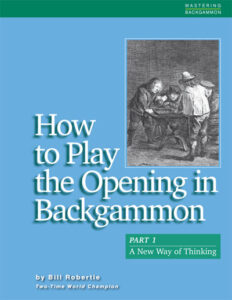I’m pleased to announce that my new book, How to Play the Opening in Backgammon, Part 1, has been published and is available for purchase here at the Gammon Press. To order, click here.
 The book is built around the kinds of typical choices that players face in the opening part of the game. For example: you throw a number that can be used to make the 5-point or the 20-point. Which point do you make? You throw a number that can make the 20-point or hit in the outfield. What’s right? A few opening plays are forced, but the non-forced plays boil down to choices like this. How do you make these decisions?
The book is built around the kinds of typical choices that players face in the opening part of the game. For example: you throw a number that can be used to make the 5-point or the 20-point. Which point do you make? You throw a number that can make the 20-point or hit in the outfield. What’s right? A few opening plays are forced, but the non-forced plays boil down to choices like this. How do you make these decisions?
Unfortunately for people just learning the game, choices like this can’t be reduced to simple slogans like “When in doubt, make the 20-point.” When a real choice exists for an opening play, the answer will hinge on a number of factors which in varying degree will be contributing to the ultimate decision. Here are some of the ideas that bear on opening decisions:
> What’s the race? A significant racing lead favors plays that don’t leave blots and plays that contribute to escaping the back checkers. Trailing in the race favors plays that maximize contact.
> Does one play make a point? A point is an asset that may last a long time. During every turn that you hold a point is a turn where that point is restricting some of your opponent’s rolls. For a point-making play not to be best, the alternative needs to create some powerful assets or reduce some major liability.
> Has your opponent made a blocking point? If so, splitting rises in value.
> Do you have a stripped outside point? If so, adding a spare will increase its value.
> Do you have a stacked point? Unstacking it will improve your position.
These and other ideas will factor into the decision-making for any non-forced play.
__________________________________________________________________
I’ve had a number of requests to show the Table of Contents for Part 1, so here it is.
Chapter 1: The Opening Move
Chapter 2: The Reply to the Opening Move
Chapter 3: The 5-Point
3.1 The 5-Point or the 20-Point?
3.2 The 5-Point or the 21-Point?
3.3 The 5-Point or the 4-Point?
3.4 The 5-Point or the 3-Point?
3.5 The 5-Point or an Outside Point?
3.6 The 5-Point or the 7-Point?
3.7 Make the 5-Point, Breaking the 7 or 8-Point?
3.8 The 5-Point or Some Other Improvement?
3.9 Make the 5-Point or Hit Somewhere? – 1
3.10 Make the 5-Point or Hit Somewhere? – 2
3.11 Make the 5-Point or Hit Two Checkers?
Chapter 4: The 20-Point
4.1 The 20-Point or the 4-Point?
4.2 The 20-Point or the 9-Point?
4.3 Make the 20-Point or Hit? – 1
4.4 Make the 20-Point or Hit? – 2
Chapter 5: The 4-Point
5.1 Make the 4-Point or Hit?
5.2 Make the 4-Point or Double-Hit?
5.3 Make the 4-Point or a Good Anchor?
5.4 Make the 4-point, Breaking the 8-Point?
The opening in backgammon is a big subject, and trying to fit it all into a single book would have been too unwieldy. The book will appear in three parts, spaced about three months apart. Look for Part 2 sometime in June.





